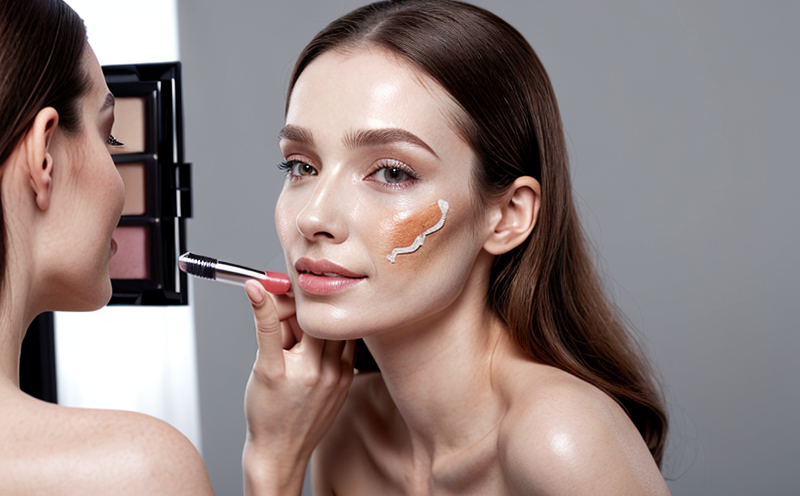In Vivo SPF Testing of Cosmetic Sunscreens
The in vivo sun protection factor (SPF) testing is a crucial step in ensuring that cosmetic sunscreens meet the stringent standards required to protect consumers from harmful ultraviolet (UV) radiation. This method involves assessing how effectively a sunscreen can prevent skin damage caused by UV light, specifically UVA and UVB rays. It is an essential part of the regulatory process for sunscreen products, as it ensures safety and efficacy.
The testing procedure typically involves exposing human volunteers to standardized doses of ultraviolet radiation under controlled conditions. The SPF value is determined by comparing the amount of UV radiation that causes erythema (sunburn) on treated skin against untreated control skin. This process measures not only the immediate protection provided but also how long it lasts.
Understanding the complexities involved in SPF testing highlights its significance for both manufacturers and regulators. For instance, the American Academy of Dermatology Association recommends using broad-spectrum sunscreen with an SPF value of at least 30 to effectively protect against both UVA and UVB rays. This underscores why accurate SPF testing is vital.
One key aspect of in vivo SPF testing is the use of standardized methods such as those outlined in ASTM E1729-22. These guidelines provide a framework for consistent testing across laboratories, ensuring reliability and comparability of results. Additionally, the European Union has specific requirements for cosmetic products that require rigorous SPF testing to ensure compliance with Directive 2003/15/EC.
The test involves several steps: preparation of the sunscreen sample, application onto the skin of volunteer participants, exposure to controlled UV radiation, and subsequent evaluation of the treated areas compared to control samples. This process is repeated multiple times to ensure accuracy and reliability of results. The data collected helps manufacturers fine-tune their formulations to meet regulatory standards.
Another critical element in SPF testing is understanding its limitations. While it provides valuable insights into a sunscreen’s ability to block UV radiation, it does not fully capture the broader spectrum of photoprotection that sunscreens offer. Therefore, additional tests like UVA and UVB irradiance measurements may be necessary for comprehensive evaluation.
Given these considerations, in vivo SPF testing remains an indispensable tool in the development and quality assurance of cosmetic sunscreens. It ensures that products are effective, safe, and meet global regulatory requirements, thereby safeguarding consumer health and well-being.
Scope and Methodology
The scope of in vivo SPF testing encompasses the evaluation of a sunscreen's ability to protect against both UVA and UVB radiation. This comprehensive approach ensures that the product not only provides immediate protection but also lasts for an extended period, which is crucial for effective photoprotection.
Methodologically, the process begins with selecting appropriate volunteers who represent diverse skin types. The sunscreen sample is then applied according to specific protocols recommended by industry standards such as ASTM E1729-22. Following application, participants are exposed to controlled UV radiation in a laboratory setting.
UV exposure levels are precisely calculated and monitored using advanced spectroscopy equipment. After the exposure period, the treated skin areas are evaluated for signs of erythema by trained dermatologists or other qualified personnel. This evaluation is compared against untreated control samples to determine the SPF value. The entire process is repeated several times to achieve statistically significant results.
For a deeper understanding, here’s a summary table detailing some key parameters:
| Parameter | Description |
|---|---|
| Sunscreen Sample Preparation | Application method and quantity according to ASTM E1729-22. |
| UV Exposure Conditions | Type of radiation, intensity, and duration. |
| Evaluation Criteria | Measurement of erythema on treated skin versus control. |
| Data Analysis | Determination of SPF based on comparative analysis. |
Industry Applications
- In vivo SPF testing is pivotal for cosmetic and pharmaceutical companies developing new sunscreen products.
- It also plays a crucial role in the quality assurance processes of existing products to ensure they meet regulatory standards.
- The method is used by regulatory bodies like the FDA and EMA to approve new formulations or changes to existing products.
- Beyond regulation, it supports research into the photoprotective properties of various ingredients and formulations.
- Manufacturers use these results to optimize their product lines for better performance and market competitiveness.
International Acceptance and Recognition
In vivo SPF testing is widely accepted and recognized by international standards organizations. The ASTM E1729-22 standard, among others, sets the benchmarks for this type of testing.
- American Society for Testing and Materials (ASTM)
- European Committee for Standardization (CEN)
- International Organization for Standardization (ISO)
- World Health Organization (WHO)
This standard ensures that SPF testing results are consistent and comparable across different regions, which is vital for global trade in cosmetic products.





